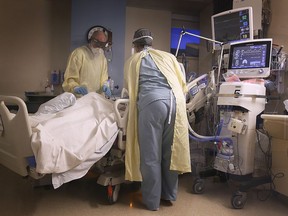
Article content
Windsor Regional Hospital’s Chief of Staff Dr. Wassim Saad says the preliminary stages of Omicron in the area have revealed a variant impacting the local population differently based on age and vaccination status than previous COVID-19 waves.
Advertisement
Article content
While those who are partially or unvaccinated continue to see infections and resulting hospitalizations spread across the board from age zero on up, those who are vaccinated and under 60 have seen their chances of ending up in hospital reduced.
“If you look at what’s happening with Omicron in the rest of the province and the world, if you’re fully vaccinated, you have less than a one per cent chance of ending up in the ICU or dying from COVID,” Saad said.
Saad said a snapshot Thursday of the hospital’s own age-based data reflects the picture seen elsewhere. At the time, there were only three hospitalizations of patients under 60 years of age among the vaccinated and zero cases under 40 among the total of 19 vaccinated patients.
Advertisement
Article content
Of the 12 unvaccinated or partially vaccinated patients in hospital primarily for COVID, five were under 60 with two of those were under 40 and one was between zero and nine years.
“If you’re unvaccinated you can see the trend from zero to nine all the way up to 80–89-year-olds evenly distributed similar to what we were seeing in previous waves,” Saad said. “People to need to recognize that.”
What these vaccines do is prevent significant, serious illness and hospitalizations and prevent deaths.
Saad said another differing aspect of Omicron is the demographics of the vaccinated patients that do need hospitalization. “In the first two waves, we were admitting 20-, 30-, 40-year-old people who had almost no comorbidities,” Saad said.
“What we’re seeing right now with those who are fully vaccinated, the ones getting admitted to hospital had significant comorbidities. We’re talking transplant patients, patients with multiple issues like blood pressure, diabetes, cholesterol, heart disease.”
Advertisement
Article content
With a surge of new cases over the weekend, the number of people at Windsor Regional has climbed to 67 on Monday.
Forty-five of those people were being treated primarily for COVID-19, with 25 fully vaccinated, four partially vaccinated and 16 unvaccinated. Seven of the 10 people in intensive care are unvaccinated or partially vaccinated.
Saad added the similarity in the numbers of vaccinated and non or partially vaccinated patients is also misleading. The 25 vaccinated patients are coming from 80 per cent of the local population that’s been fully vaccinated versus a similar number from only 20 per cent.
“Clearly the percentages and the chance you end up in hospital vary significantly on whether you are fully vaccinated or partially vaccinated or completely unvaccinated,” Saad said.
Advertisement
Article content
Saad added it’s a myth the vaccines have failed if they allow for infections. He explained the vaccines are intended to combat the worst-case scenario of winding up in the ICU.

In Ontario there were 9,706 new cases of Omicron reported Monday with 438 patients in ICUs. In comparison, at the height of the previous wave May 1, 2021, prior to an extensive vaccine rollout, there were 2,304 cases reported that day with 828 patients in the ICU.
“These are not what we call sterilizing vaccines,” Saad said. “Sterilizing vaccine will prevent you from getting an infection in the first place.
“There are very few vaccines that do that. What these vaccines do is prevent significant, serious illness and hospitalizations and prevent deaths.
“There’s no question these vaccines are doing that in keeping vaccinated patients out of our ICUs.”
Omicron having different impact locally than previous variants - Windsor Star
Read More



No comments:
Post a Comment